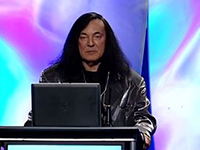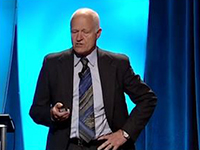Cover Story
Overcoming ‘Us’ and ‘Them’

In 1999, Wen Ho Lee, a Taiwanese American scientist working at Los Alamos National Laboratory, was indicted by a grand jury for giving US nuclear secrets to China. As dozens of criminal counts piled up against Lee, it was easy for public opinion to make its ruling about his guilt. But the government’s case turned out to be deeply flawed, and after his release from prison for lack of evidence, Lee wrote a book about the experience called My Country Versus Me.
At the root of such an event is humanity’s strong tendency to divide itself into groups of “us” and “them,” said APS Past President Mahzarin R. Banaji of Harvard University during the Fred Kavli Keynote Address at the 2014 APS Annual Convention. In a lively talk peppered with jokes amid somber descriptions of human judgment, Banaji explained how this pernicious tendency emerges in the mind without our awareness. But she stressed that recognizing these behavioral blind spots is the first step to overcoming them.
“Let us understand what our own — I’ll say blind spots — are up to, because we may then at least have a chance to upset their designs,” said Banaji, borrowing from evolutionary biologist Richard Dawkins, “something that no other species has ever aspired to do.”
Banaji is codeveloper of the Implicit Association Test, a tool capable of measuring unconscious biases that don’t appear in self-report measures. The test pairs images with words and measures how quickly users respond to the pairings. When a white face is paired with a positive word, for instance, users tend to respond faster than when a black face is paired with the same word — and vice versa for negative words. Banaji said the IAT has been used more than 16 million times since its creation in 1998. (Anyone can take the test online at implicit.harvard.edu/implicit.)
Assigning Values
The test has revealed two key elements of human behavior. The first is that people strongly identify with people in their own social groups. The second is that despite this identification, the value society places on a group can trump the individual’s own in-group attitude.
The degree of in-group identification detected by the IAT is overwhelming. In the context of the Wen Ho Lee case, Banaji and collaborators found that people associated American symbols with white European faces far more quickly than with Asian faces. That implicit bias held when the Asian faces were replaced with famous Asian Americans, such as Connie Chung, and the European faces were replaced with famous white foreigners, such as Hugh Grant. It even held when Asians were replaced with Native Americans, suggesting that in-group skin color — not settlement or immigration patterns — really determined the us–them effect.
“This is why the Wen Ho Lee events may end up being the way they are,” Banaji said.
Equally intriguing, though, are the times when people don’t value their own group above others. Working with APS Fellow John T. Jost of New York University, Banaji has found evidence that people will be biased against their in-group to protect a larger system of social values. This tendency, known as “system justification,” emerges most clearly in IAT tests of the young and the old. As a person’s age increases, so does their preference for the elderly — a clear sign of in-group preference. But both young and old IAT users associate positive words with the young and negative ones with the elderly, reflecting social norms.
Keeping It in Check
Banaji’s work is often characterized as controversial, and in some ways it’s easy to see why. If the thought patterns she’s revealing are genuine, that means people are automatically judging those around them based on flimsy superficial information. As the world progresses into a more explicitly tolerant place, that’s not a great feeling to have.
But despite such controversy, Banaji said her work is based on three totally noncontroversial psychological principles. The first, known as associative learning, simply says that our brains learn to connect two things very quickly. The second, bounded rationality, says that humans are imperfect decision makers. The third, unconscious inference, says that people make rapid assessments of a complex world.
The good news, said Banaji, is that most people wish to keep their unconscious behavior in line with their explicit values. That means that appreciating the persistence of implicit biases, through tests like the IAT, can help us create ways to keep our us–them behavior in check. Sometimes that might mean developing
an information-based tool that helps remove judgment from a decision. Sometimes it’s a simple reminder to ourselves that events like the Wen Ho Lee case can have tragic outcomes.
“On the one hand, it’s true I do study the dark side of human nature — all the ways in which I’m screwed up and so are all of you,” said Banaji. “But with every such discovery there is the hope that being the kind of species we are, we will find ways around it.”





APS regularly opens certain online articles for discussion on our website. Effective February 2021, you must be a logged-in APS member to post comments. By posting a comment, you agree to our Community Guidelines and the display of your profile information, including your name and affiliation. Any opinions, findings, conclusions, or recommendations present in article comments are those of the writers and do not necessarily reflect the views of APS or the article’s author. For more information, please see our Community Guidelines.
Please login with your APS account to comment.